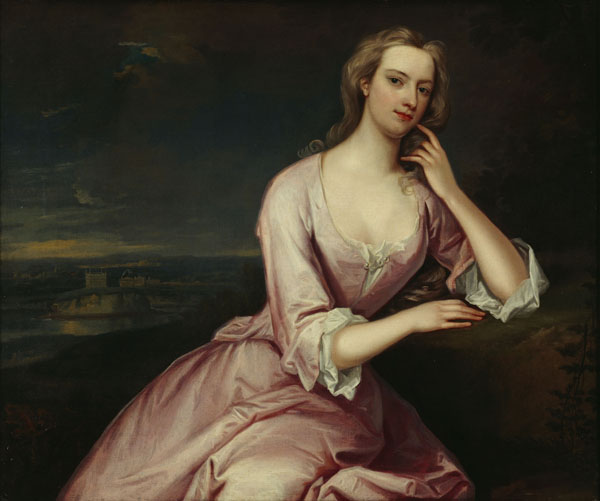by Scott Mehl © Unofficial Royalty 2020
Henrietta Howard, Countess of Suffolk, became the mistress of the future King George II of Great Britain in 1714 and maintained a relationship with him until 1734.

Henrietta Howard, Countess of Suffolk – source: Wikipedia
Henrietta Hobart was born in 1689 at Blickling Hall in Norfolk, the family home of her parents, Sir Henry Hobart, 4th Baronet of Intwood, and Elizabeth Maynard. Sir Henry had been in the household of King William III of England, serving as Gentleman of the Horse, and served under the King during the Battle of the Boyne. He was later appointed Vice-Admiral of Norfolk, and served in the House of Commons, representing several constituencies.
Henrietta had two siblings:
- Catherine Hobart (circa 1690 – 1725) – married Charles Churchill, no issue
- John Hobart, 1st Earl of Buckinghamshire (1693 – 1756) – married (1) Judith Britiffe, had issue; (2) Elizabeth Bristow, had issue
In 1698, Henrietta’s father died from injuries sustained during a duel, and her mother died of illness three years later. Orphaned at just 12 years old, Henrietta became the ward of Henry Howard, the 5th Earl of Suffolk. Five years later, she married the Earl’s younger son, Charles Howard, on March 2, 1706. Charles would eventually become the 9th Earl of Suffolk in 1731. From all reports, the marriage was an unhappy one. Charles was a compulsive gambler and drinker and was often physically abusive to Henrietta. However, the couple did have one son together:
- Henry Howard, 10th Earl of Suffolk (1706-1745) – married Sarah Inwen, no issue
In 1714, Henrietta and her husband traveled to Hanover, with the hope of getting into the circle of the future King George I and securing themselves a better financial future. Their venture was successful, and following George’s accession to the British throne, the couple returned to England and both received positions within the Royal Household. Charles was appointed Groom of the Bedchamber to the new King, and Henrietta was appointed a Woman of the Bedchamber to the new Princess of Wales, Caroline of Ansbach. Through this role, Henrietta met and became the mistress of the Prince of Wales – the future King George II.

The Prince of Wales, c1716. source: Wikipedia
Over the next several years, Henrietta and George’s relationship continued to strengthen. However, Henrietta’s husband was not pleased with the situation. His wife was benefiting greatly from the Prince of Wales’ generosity but he was not. Threatening to cause a scandal, he was quickly compensated in exchange for looking the other way. The Prince of Wales arranged for Charles to be given a large annual pension, an appointment as Deputy Lieutenant of Essex, and a high-ranking commission in the Coldstream Guards. The couple maintained their marriage publicly, but for the most part, lived separate lives. They would later officially separate in 1727.

Marble Hill House. photo: By Jim Linwood from London – North Face Of Marble Hill House, Twickenham – London., CC BY 2.0, https://commons.wikimedia.org/w/index.php?curid=50570204
In 1723, the Prince of Wales gave Henrietta a very large gift of about 11,500 pounds worth of stocks, jewelry, furniture, and other furnishings. Careful to be sure that this would benefit Henrietta alone, George made sure that it was stipulated that Henrietta’s husband would have no claim to any of this gift. The following year, through a trustee, Henrietta purchased over 25 acres of land along the River Thames in Twickenham on which she built Marble Hill House. There, Henrietta hosted some of the most influential artists, intellectuals, and politicians of the day, establishing a court that rivaled that of Kensington Palace.
In 1727, several major changes happened in Henrietta’s life. King George I died, and the Prince of Wales succeeded as King George II. Continuing with her service to the royal court, she was appointed Mistress of the Robes to the new Queen Caroline. Around the same time, she and her estranged husband Charles officially separated but did not divorce due to the scandal it would have caused. In 1731, Charles succeeded to the Earldom of Suffolk, and Henrietta became the Countess of Suffolk.
Widowed in 1733, the now Dowager Countess of Suffolk left the royal court in 1734 after her relationship with King George II ended. She made Marble Hill House her primary residence and married again in 1735. Her second husband was The Honourable George Berkeley, a younger son of the 2nd Earl of Berkeley, and a Member of Parliament. Henrietta and her second husband raised her widowed brother’s children and enjoyed a very quiet and happy family life. Henrietta and her husband, from all accounts, were tremendously happy together and spent their time traveling in Europe, and enlarging and renovating Marble Hill House and the surrounding park. George Berkeley died in 1746, and Henrietta spent her remaining years at Marble Hill House with her extended family. She died there on July 26, 1767.
This article is the intellectual property of Unofficial Royalty and is NOT TO BE COPIED, EDITED, OR POSTED IN ANY FORM ON ANOTHER WEBSITE under any circumstances. It is permissible to use a link that directs to Unofficial Royalty.
